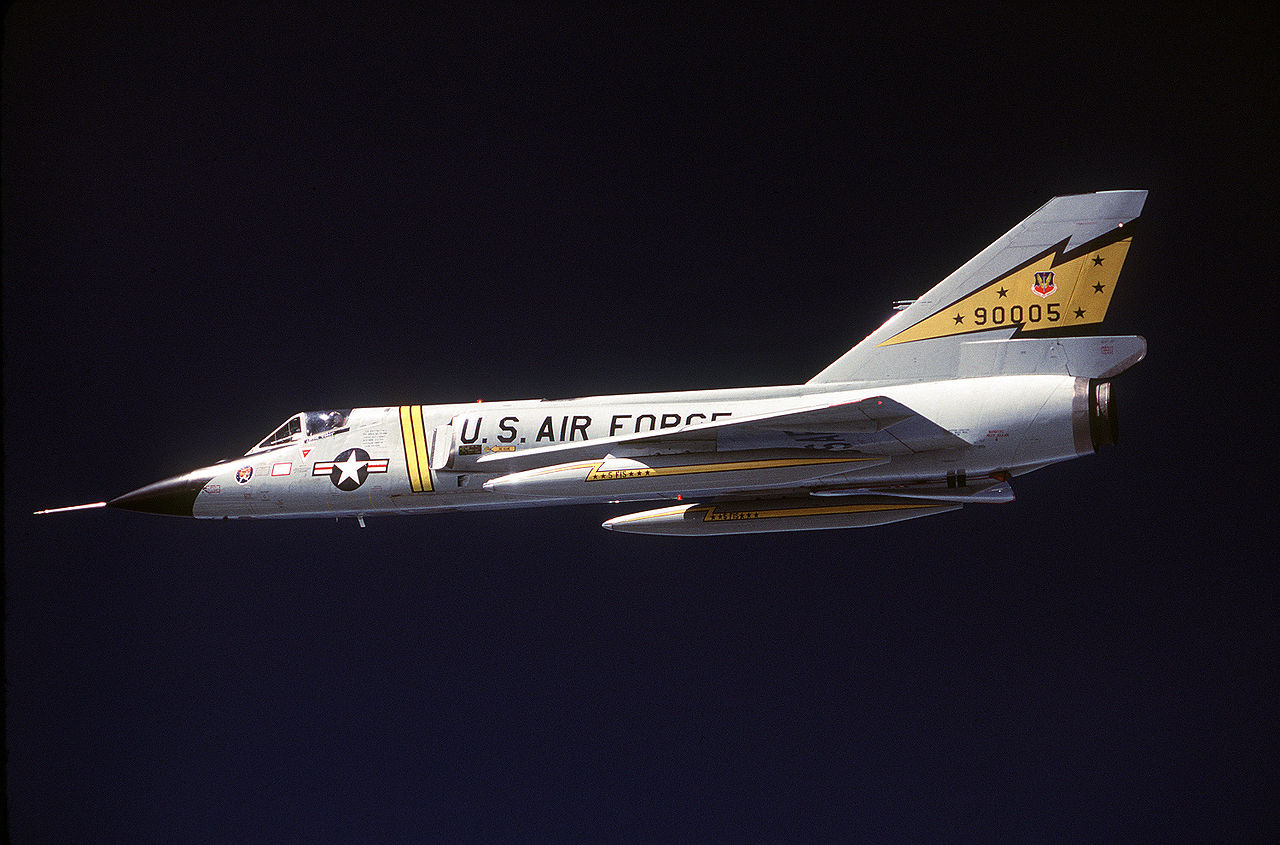A Concept Refined:

The Air Force remained infatuated with the F-102 despite the plane’s mediocre career report. Early on in its operational life, as problems began to appear, the Air Force committed to spending additional funds on the project, which would see a secondary aircraft develop, the F-102B. The Air Force placed its order for the F-102B in November 1955. However the design was designated the F-106 because enough changes had been made in the design to rightly recognize the aircraft as an entirely new product.
When it first flew on Dec. 26, 1956, the F-106 surpassed the many expectations, which had been established for the F-102 originally, and even exceeded the expectations that many in the military had for the F-106. Not only was the airplane capable of exceeding Mach 1 in level flight, it was also able to exceed Mach 2 (1,522 mph).
Much like the F-102, the F-106 had been designed around the deployment of a fire control system, in this case, the Hughes MA-1, which was originally in development for the F-102 but had been replaced by the simpler E-9 when program delays on the MA-1 had threatened the prompt delivery of the F-102. Despite the additional years of research and development allotted to the MA-1, it still needed more than 60 substantial upgrades in its service lifetime on board the F-106. The technology was considerably advanced for the 1950s and 1960s, as the MA-1 system allowed ground controllers to fly the airplane onto target from the ground if needs dictated doing so.
Despite its many successes, the F-106 would find itself overcome by events, as the age of the ballistic missile dawned and it became apparent that dollars spent on interceptors would not be remotely efficient in the strategic nuclear exchange of the future. The initial F-106 design had no gun, but at some point Project Six Shooter launched, which saw the F-106 converted with a bubble canopy and receiving a gun as well as an optical gunsight. During this program, the F-106 demonstrated that despite its intended performance as an interceptor, it was actually a capable dogfighter, even able to defeat the F-4 in some instances. Though it certainly had potential as a fighter, the desire to move onward toward the “Teens”, the modern series of fighter jets, saw developmental dollars shifted to new platforms instead of enhancing older ones. To this date, the F-106 remains the USAFs last purpose-built interceptor, having been totally replaced in the active inventory in 1981 by F-15As.
The Best Aircraft the Air Force Never Purchased:

If you’ve been paying attention, you will realize that there have been several missing numbers in the sequence of the Century Series aircraft. Where is the F-103, and what of F-107, F-108 and F-109? The simple answer is that the designs tendered for these designations were not accepted for wide-scale production.
The F-103 was a Republic concept airplane, which never advanced beyond mock-up stage. It was named the Thunderwarrior and was anticipated as a competitor to the F-102 design.
The XF-108 Rapier was a heavyweight super high-speed interceptor that shared its developmental costs with the experimental XB-70 Valkyrie. The two would have used similar engines, and took aerodynamic cues from their mirrored design processes. The XF-108 was supposed to use the Hughes GAR-9 missile, with the XB-70 using the AIM-47. However, with the cancellation of the XF-108 developmental program, the YF-12, an armed version of the SR-71 Blackbird, took on the GAR-9.
McDonnell requested the F-109 designator for its interim F-101 derived interceptor design, which was intended to complement the F-102, but the Air Force decided to designate that platform as the F-101B. Sometime later, Bell would also seek the F-109 designator for its own Century Series project, and futile attempt at a supersonic VTOL tilt-jet fighter aircraft (internally designated the D-188A).
Though these concept aircraft were never produced, the F-107 advanced beyond the stages of conceptualization. It has long been described as the best aircraft the Air Force never purchased. It was a follow-on development intended to succeed the F-100, and where the F-100 was originally an air superiority fighter, the F-107 was a purpose-designed tactical fighter-bomber. Unfortunately, the aircraft was in direct competition with the Republic F-105 Thunderchief for the same government dollars. The F-105 won the contract, and the three 107 prototypes slipped by the wayside. One of its most peculiar features is the dorsal intake, which evolved due to the requirement for a belly hardpoint capable of carrying a larger nuclear weapon than had been possible on the conventional F-100.
The F-110 Spectre;

For those of you who read the reference to the 1962 Air Force video “TAC on Target” and rushed off to YouTube to watch it, you will have been rewarded with an excellent segment on the F-110 Spectre. Some of you might have even have remarked that the F-110 looks curiously like the F-4 Phantom II. That is because they are one and the same. While the Air Force was pushing aircraft through the Century Series development programs, the Navy was undertaking a similar process, with its aircraft enduring many of the same developmental growing pains. The Navy simply did it without the benefit of a catchy moniker. Navy platforms such as the F4D Skyray and F8U Crusader achieved many of the same milestones and breakthroughs for carrier-borne airplanes, and the Naval developmental requirements issued to the McDonnell company that lead to the F4H Phantom II were very much in line with imagined Air Force needs for an aircraft that could merge the interceptor and tactical fighter bomber roles. Curiously, during the F4H development, the Navy examined the names Satan and Mithras because it, like the Voodoo, had been descended from the Demon.
While the Air Force was somewhat interested in the airplane, it must be said that Robert McNamara, then the Secretary of Defense, had been pushing substantially for all branches of the service to use the same aircraft as a perceived cost-cutting mechanism. Responding to this pressure, the Air Force took a pair of F4Hs from the Navy on loan, creating the designation F-110A. While evaluating the airplanes, the Air Force created its own list of requirements. In September 1962, with the commitment to adopting the same aircraft, the Tri-Service aircraft designation system was put in place and was restarted sequentially at 1 again, making the F-110A/F4H into the F-4 Phantom II.
It is interesting to note that the F-111, also victim to the proposed mutual use of aircraft designs between the Air Force and Navy, was never actually adopted by the Navy, and was therefore able migrate through the changes in nomenclature, remaining the F-111. Though not strictly considered members of the Century Series, the long-term use of F-4s and F-111s into modern times has continued much of the legacy of those leaps and bounds made in aircraft design and development in the 1950s and 1960s. Though the F-4 remains active today in foreign countries, most have been replaced by the fighters pushed through as a part of a coherent development plan spurred by the conflict in Vietnam. We know these aircraft today as the “Teens,” The Grumman F-14 Tomcat, McDonnell Douglas F-15 Eagle, General Dynamics F-16 Fighting Falcon, and the McDonnell Douglas F/A-18 Hornet.
This article was original published on the The Dispatch, the official magazine of the Commemorative Air Force.
Related Articles
Born in Milan, Italy, Moreno moved to the U.S. in 1999 to pursue a career as a commercial pilot. His aviation passion began early, inspired by his uncle, an F-104 Starfighter Crew Chief, and his father, a military traffic controller. Childhood adventures included camping outside military bases and watching planes at Aeroporto Linate. In 1999, he relocated to Atlanta, Georgia, to obtain his commercial pilot license, a move that became permanent. With 24 years in the U.S., he now flies full-time for a Part 91 business aviation company in Atlanta. He is actively involved with the Commemorative Air Force, the D-Day Squadron, and other aviation organizations. He enjoys life with his supportive wife and three wonderful children.









When talking to an ex 104 pilot at Kalamazoo air zoo, he remarked that he could fly the 104 at Mach three but only for a short time as the windscreen would start to melt!